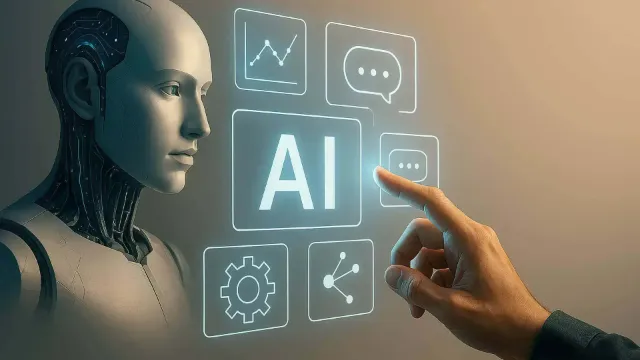Difference Between LLM VS Generative AI VS Agentic AI

The realm of artificial intelligence is changing at an amazing speed, and with newer AI kinds popping up, it may be a bit of a struggle for business executives to stay updated. If you are looking into AI development services, it is likely that you have come across these terms: “LLM,” “Generative AI,” and “Agentic AI.” But what are these, and how can they contribute to your business growth? By reading this piece, you will understand the differences between LLM vs Generative AI vs Agentic AI, see their use cases in the real world.
And get an idea of the reasons why the right AI decision can be a competitive advantage for your business. In case, you aim at task automation, customer experience personalization, or innovative product creation through low-code no-code development services, it is essential to be aware of your choices.
Understanding Generative AI
Generative AI refers to any artificial intelligence system that produces new content based on recognized patterns in the data. Such a system may come up with text, images, or audio; a video; or even code. Whereas conventional software simply adheres to programmed rules, generative AI figures out from huge datasets and makes content that sounds fresh and original.
Some of the ways companies use generative AI technologies are:
- Write product descriptions, emails, or news articles automatically
- Generate artwork for marketing campaigns
- Create realistic voiceover audio or video scripts
- Develop chatbots that can answer customer queries in real time
Generative AI is a broad term that encompasses a lot of newer AI tools that are available today, such as large language models. If your business is planning to implement AI development services, you will probably find that most of the solutions are related to generative AI for creating content, personalizing, and automating.
Also Read: Best AI Startup Ideas That Will Dominate the Tech Industry
What Are Large Language Models (LLMs)?
LLMs, or large language models, are a specific type of generative AI. Their main function is to understand and produce human language. Trained in vast libraries of books, articles, and websites, LLMs can write, summarize, translate, answer questions, and even have natural conversations.
Examples of popular LLMs include OpenAI’s GPT-4, Google’s Bard, and open-source models like BLOOM. They are powerful tools for companies looking to automate customer support, create multilingual content, or analyze customer feedback at scale.
Some practical uses of LLMs include:
- Automating responses in customer service chatbots
- Summarizing technical documents for business reports
- Translating ads or product info for new regions
- Powering voice assistants and smart replies in email apps
LLM vs Generative AI is not always an “either-or” choice, since LLMs are actually a subset of generative AI dedicated to language tasks. When choosing AI/ML development company partners, understanding this relationship helps you invest wisely.
Introducing Agentic AI
The agentic AI systems are fitted to be autonomous, implying that they are able to decide, arrange actions, resolve issues as well as perform multi-stage tasks with minimal to no human assistance.
Instead of waiting for instructions, Agentic AI can:
- Set and pursue goals (such as handling a customer return from start to finish)
- Gather information or resources automatically (like retrieving inventory data)
- Make real-time decisions based on changing data
- Learn from outcomes and adjust strategies over time
Think of agentic AI as not just producing content, but actively managing workflows and driving business outcomes. This makes agentic AI solutions ideal for companies that want more than automated content; they want proactive optimization and process automation.
Also Read: AI in Cybersecurity: Utilizing AI as a Deterrent to AI
Key Differences: LLM vs Generative AI vs Agentic AI
Here’s a quick overview to help you see the main contrasts:
| Feature | Generative AI | LLM (Large Language Models) | Agentic AI |
| Core Capability | Content Creation | Language Understanding & Generation | Goal-driven Action |
| Output | Text, Images, Audio, Code | Text-based Outputs | Process Automation & Decision Making |
| Autonomy | Needs Prompts | Needs Prompts | Operates with Minimal Guidance |
| Real Business Use | Content Generation, Art, Code | Chatbots, Summarization, Translation | End-to-End Workflow Automation |
| Popular Example | DALL-E, Midjourney | GPT-4, Bard, BLOOM | Customer Support Automation, Executive Assistants |
Generative AI is the broadest, focusing on producing new content in many formats, but usually only after getting a user prompt.
LLMs specialize in language and handle complex language tasks, but they are still reactive, not autonomous.
Agentic AI adds the ability to independently complete multi-step goals, act proactively, and adjust to new inputs or changing situations.
How They Work Together
Many businesses gain the most value when these AI types work together. A practical example:
- A generative AI model creates the first draft of a marketing email.
- An LLM tailors the language for your target audience.
- An agentic AI system schedules the campaign, analyzes the results, and keeps refining the approach automatically.
This mix lets organizations leverage the strengths of each AI approach: creativity, language skill, and autonomous action for smarter operations and better outcomes.
Why These AI Approaches Matter for Modern Businesses
Whether you’re an e-commerce startup or an enterprise brand, AI development services now go far beyond simple chatbots. Here’s how:
- Low-code no-code development services enable companies to explore and develop AI fast, without the need to have deep-coding knowledge.
- The solutions of generative AI provide marketing and creative teams with the ability to scale content creation and personalize campaigns.
- It is possible to customize the LLM and Agentic AI solutions to fit the use cases of 24/7 customer support, automated workflows, or real-time data analysis by the companies that cooperate with an experienced AI/ML development company.
- They are being used in manufacturing, retail, healthcare, and financial services to streamline operations, enhance accuracy, and release human talent to concentrate on senior strategy.
Choosing the Right AI Solution
When selecting between LLM vs Generative AI vs Agentic AI, consider factors like:
- The main business problem to solve (content creation, process automation, decision-making)
- The desired level of autonomy: do you want tools that act independently or only create content on request?
- The importance of scalability, security, and explainable AI in your industry
By working with an AI development services provider skilled in low-code no-code development and up-to-date on the latest agentic AI solutions, you can ensure your project fits both your goals and your resources.






